Managing Innovation: Theory Application and Future Development Report
VerifiedAdded on 2023/01/09
|20
|3984
|51
Report
AI Summary
This report provides a comprehensive overview of innovation, focusing on the diffusion of innovation theory and disruptive innovation theory. It begins with an introduction to the concept of innovation and then delves into the core of the diffusion of innovation theory, explaining its stages (knowledge, persuasion, decision, implementation, and continuation) and adopter categories (innovators, early adopters, early majority, late majority, and laggards). The report evaluates the theory's benefits and limitations, including information dissemination, the number of adopters, and cultural and economic differences. The report then introduces disruptive innovation theory and its application. The report also presents a case study on Deliveroo, applying the innovation theories to analyze its business model and unique features. The report concludes with a discussion on the application of innovation theory for future development. The assignment provides a detailed analysis of different innovation theories with a practical application of the theories.
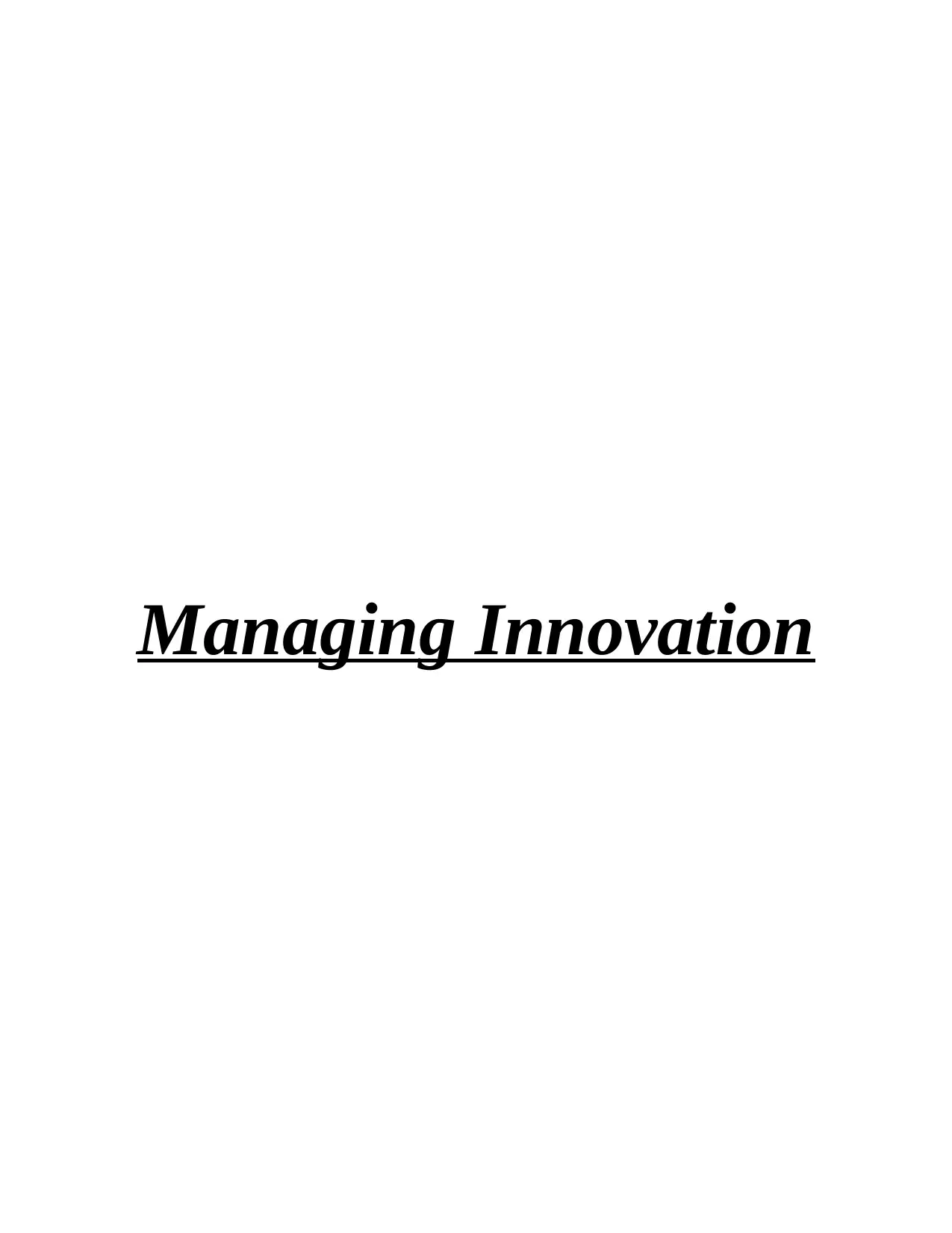
Managing Innovation
Paraphrase This Document
Need a fresh take? Get an instant paraphrase of this document with our AI Paraphraser
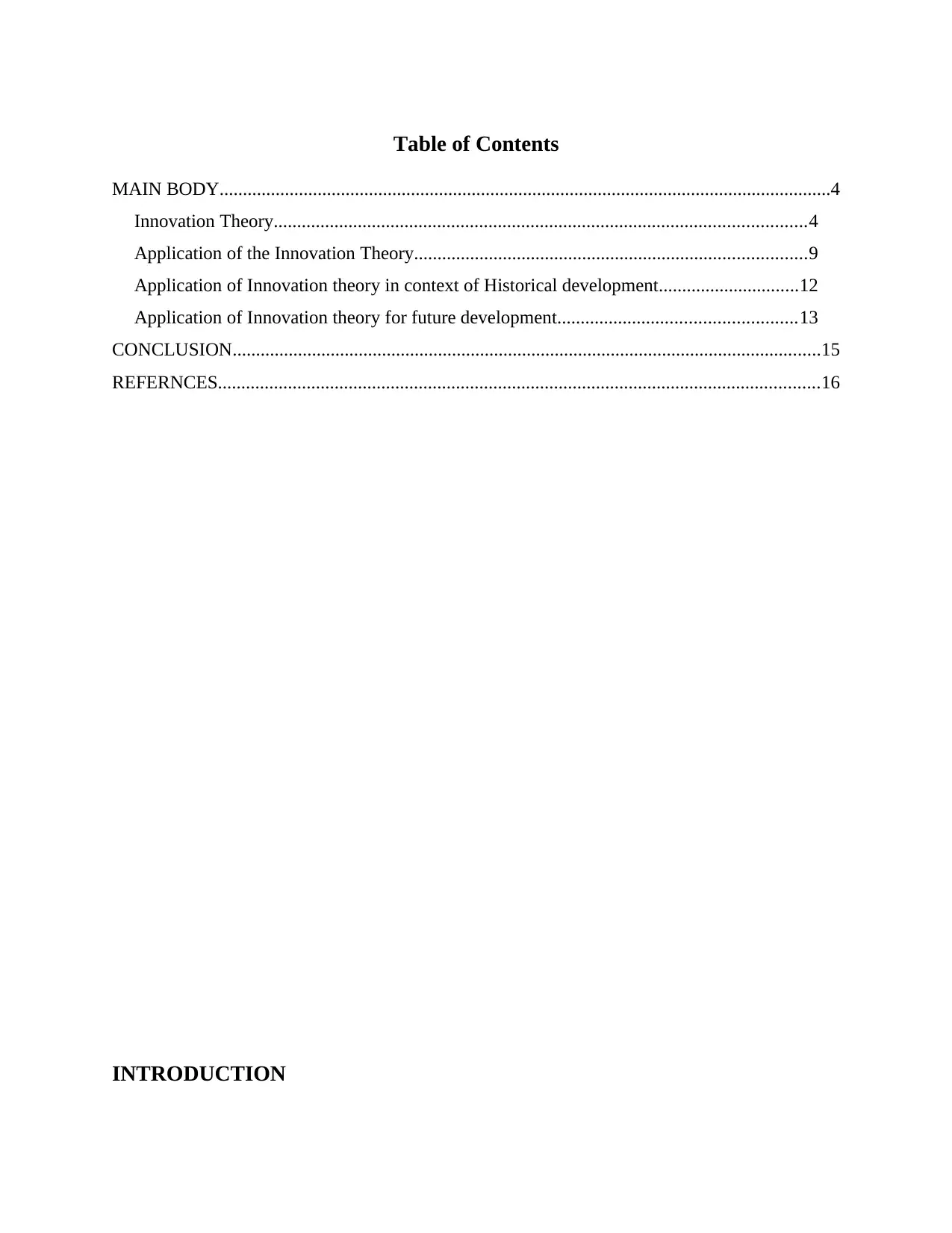
Table of Contents
MAIN BODY...................................................................................................................................4
Innovation Theory..................................................................................................................4
Application of the Innovation Theory....................................................................................9
Application of Innovation theory in context of Historical development..............................12
Application of Innovation theory for future development...................................................13
CONCLUSION..............................................................................................................................15
REFERNCES.................................................................................................................................16
INTRODUCTION
MAIN BODY...................................................................................................................................4
Innovation Theory..................................................................................................................4
Application of the Innovation Theory....................................................................................9
Application of Innovation theory in context of Historical development..............................12
Application of Innovation theory for future development...................................................13
CONCLUSION..............................................................................................................................15
REFERNCES.................................................................................................................................16
INTRODUCTION
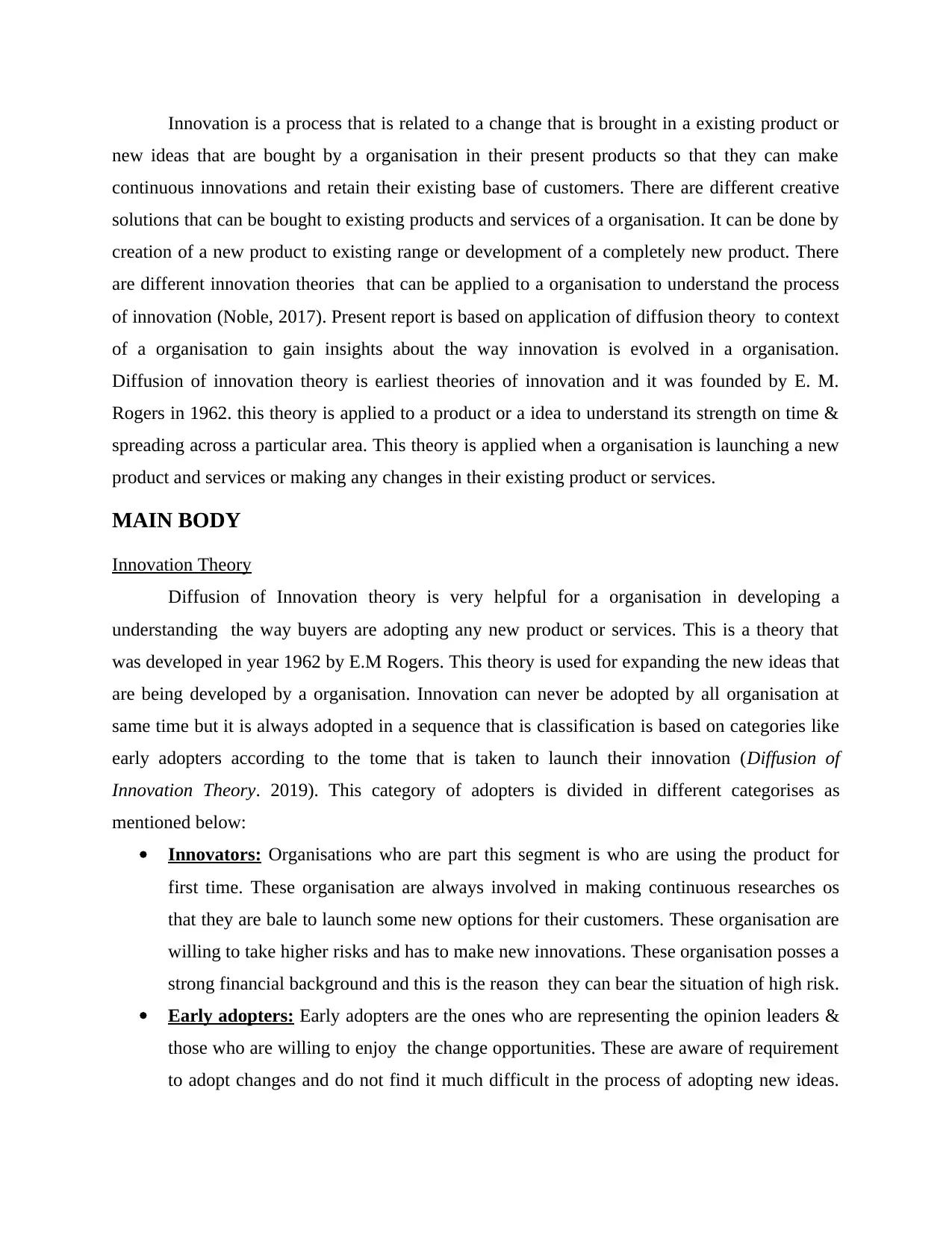
Innovation is a process that is related to a change that is brought in a existing product or
new ideas that are bought by a organisation in their present products so that they can make
continuous innovations and retain their existing base of customers. There are different creative
solutions that can be bought to existing products and services of a organisation. It can be done by
creation of a new product to existing range or development of a completely new product. There
are different innovation theories that can be applied to a organisation to understand the process
of innovation (Noble, 2017). Present report is based on application of diffusion theory to context
of a organisation to gain insights about the way innovation is evolved in a organisation.
Diffusion of innovation theory is earliest theories of innovation and it was founded by E. M.
Rogers in 1962. this theory is applied to a product or a idea to understand its strength on time &
spreading across a particular area. This theory is applied when a organisation is launching a new
product and services or making any changes in their existing product or services.
MAIN BODY
Innovation Theory
Diffusion of Innovation theory is very helpful for a organisation in developing a
understanding the way buyers are adopting any new product or services. This is a theory that
was developed in year 1962 by E.M Rogers. This theory is used for expanding the new ideas that
are being developed by a organisation. Innovation can never be adopted by all organisation at
same time but it is always adopted in a sequence that is classification is based on categories like
early adopters according to the tome that is taken to launch their innovation (Diffusion of
Innovation Theory. 2019). This category of adopters is divided in different categorises as
mentioned below:
Innovators: Organisations who are part this segment is who are using the product for
first time. These organisation are always involved in making continuous researches os
that they are bale to launch some new options for their customers. These organisation are
willing to take higher risks and has to make new innovations. These organisation posses a
strong financial background and this is the reason they can bear the situation of high risk.
Early adopters: Early adopters are the ones who are representing the opinion leaders &
those who are willing to enjoy the change opportunities. These are aware of requirement
to adopt changes and do not find it much difficult in the process of adopting new ideas.
new ideas that are bought by a organisation in their present products so that they can make
continuous innovations and retain their existing base of customers. There are different creative
solutions that can be bought to existing products and services of a organisation. It can be done by
creation of a new product to existing range or development of a completely new product. There
are different innovation theories that can be applied to a organisation to understand the process
of innovation (Noble, 2017). Present report is based on application of diffusion theory to context
of a organisation to gain insights about the way innovation is evolved in a organisation.
Diffusion of innovation theory is earliest theories of innovation and it was founded by E. M.
Rogers in 1962. this theory is applied to a product or a idea to understand its strength on time &
spreading across a particular area. This theory is applied when a organisation is launching a new
product and services or making any changes in their existing product or services.
MAIN BODY
Innovation Theory
Diffusion of Innovation theory is very helpful for a organisation in developing a
understanding the way buyers are adopting any new product or services. This is a theory that
was developed in year 1962 by E.M Rogers. This theory is used for expanding the new ideas that
are being developed by a organisation. Innovation can never be adopted by all organisation at
same time but it is always adopted in a sequence that is classification is based on categories like
early adopters according to the tome that is taken to launch their innovation (Diffusion of
Innovation Theory. 2019). This category of adopters is divided in different categorises as
mentioned below:
Innovators: Organisations who are part this segment is who are using the product for
first time. These organisation are always involved in making continuous researches os
that they are bale to launch some new options for their customers. These organisation are
willing to take higher risks and has to make new innovations. These organisation posses a
strong financial background and this is the reason they can bear the situation of high risk.
Early adopters: Early adopters are the ones who are representing the opinion leaders &
those who are willing to enjoy the change opportunities. These are aware of requirement
to adopt changes and do not find it much difficult in the process of adopting new ideas.
⊘ This is a preview!⊘
Do you want full access?
Subscribe today to unlock all pages.

Trusted by 1+ million students worldwide
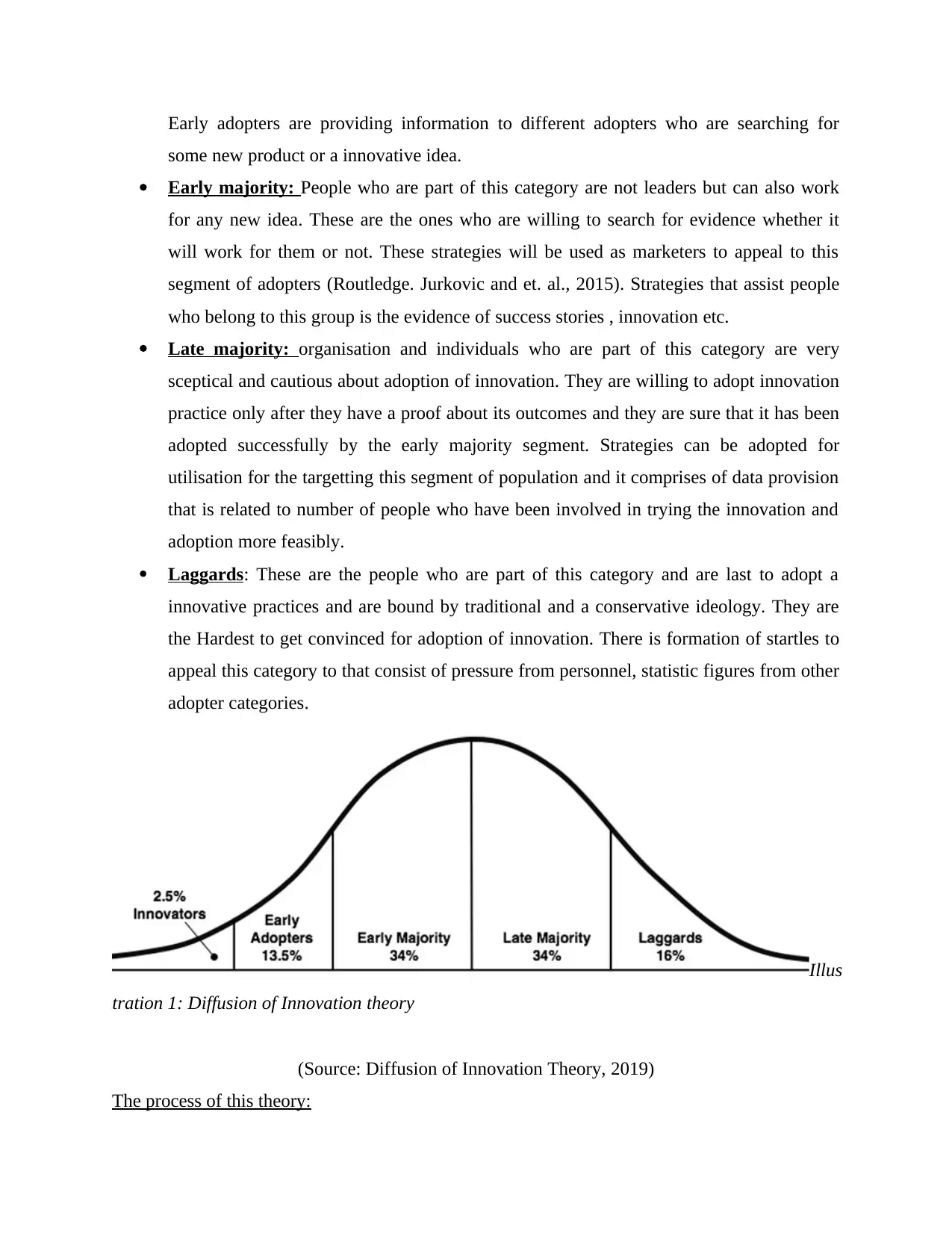
Early adopters are providing information to different adopters who are searching for
some new product or a innovative idea.
Early majority: People who are part of this category are not leaders but can also work
for any new idea. These are the ones who are willing to search for evidence whether it
will work for them or not. These strategies will be used as marketers to appeal to this
segment of adopters (Routledge. Jurkovic and et. al., 2015). Strategies that assist people
who belong to this group is the evidence of success stories , innovation etc.
Late majority: organisation and individuals who are part of this category are very
sceptical and cautious about adoption of innovation. They are willing to adopt innovation
practice only after they have a proof about its outcomes and they are sure that it has been
adopted successfully by the early majority segment. Strategies can be adopted for
utilisation for the targetting this segment of population and it comprises of data provision
that is related to number of people who have been involved in trying the innovation and
adoption more feasibly.
Laggards: These are the people who are part of this category and are last to adopt a
innovative practices and are bound by traditional and a conservative ideology. They are
the Hardest to get convinced for adoption of innovation. There is formation of startles to
appeal this category to that consist of pressure from personnel, statistic figures from other
adopter categories.
Illus
tration 1: Diffusion of Innovation theory
(Source: Diffusion of Innovation Theory, 2019)
The process of this theory:
some new product or a innovative idea.
Early majority: People who are part of this category are not leaders but can also work
for any new idea. These are the ones who are willing to search for evidence whether it
will work for them or not. These strategies will be used as marketers to appeal to this
segment of adopters (Routledge. Jurkovic and et. al., 2015). Strategies that assist people
who belong to this group is the evidence of success stories , innovation etc.
Late majority: organisation and individuals who are part of this category are very
sceptical and cautious about adoption of innovation. They are willing to adopt innovation
practice only after they have a proof about its outcomes and they are sure that it has been
adopted successfully by the early majority segment. Strategies can be adopted for
utilisation for the targetting this segment of population and it comprises of data provision
that is related to number of people who have been involved in trying the innovation and
adoption more feasibly.
Laggards: These are the people who are part of this category and are last to adopt a
innovative practices and are bound by traditional and a conservative ideology. They are
the Hardest to get convinced for adoption of innovation. There is formation of startles to
appeal this category to that consist of pressure from personnel, statistic figures from other
adopter categories.
Illus
tration 1: Diffusion of Innovation theory
(Source: Diffusion of Innovation Theory, 2019)
The process of this theory:
Paraphrase This Document
Need a fresh take? Get an instant paraphrase of this document with our AI Paraphraser
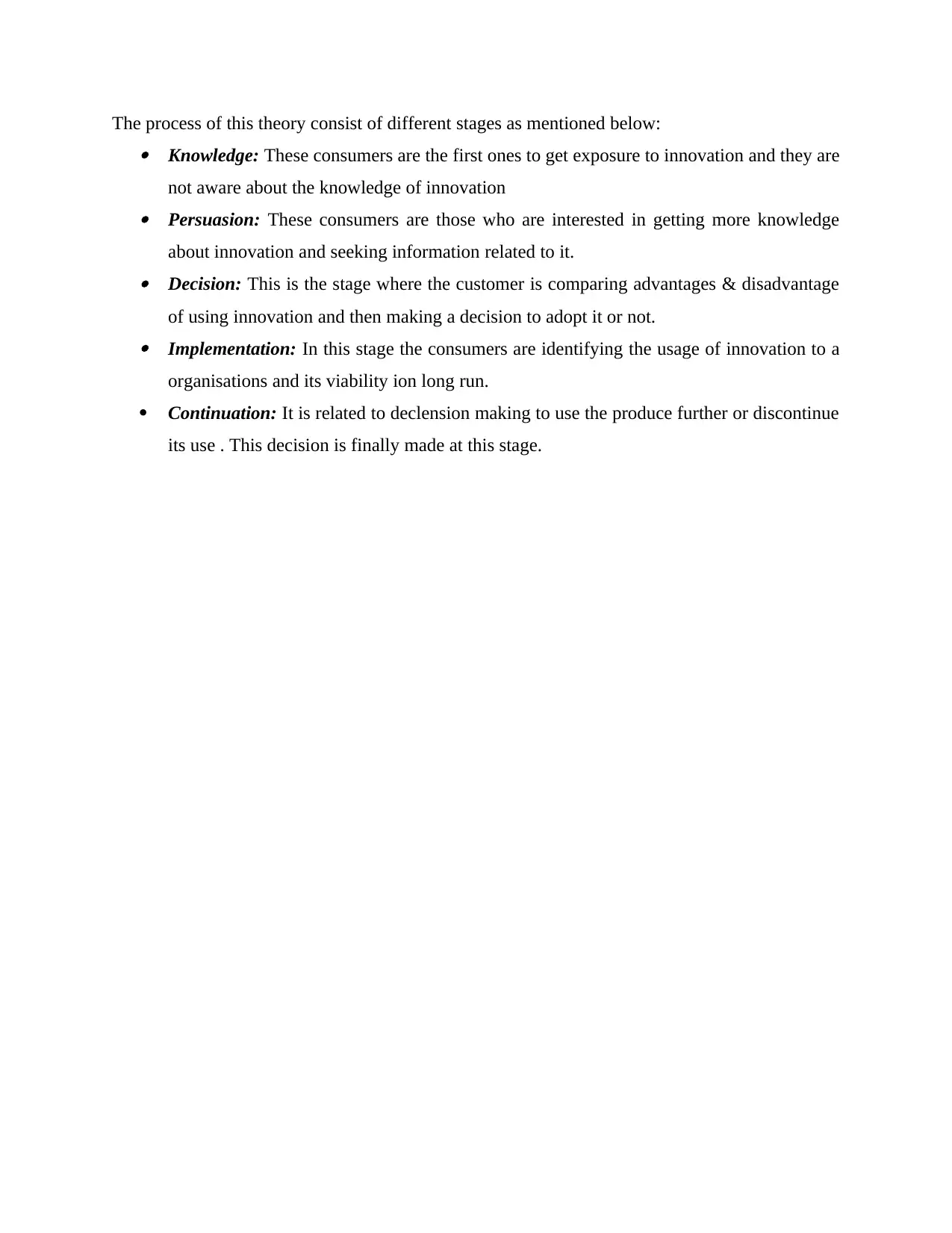
The process of this theory consist of different stages as mentioned below: Knowledge: These consumers are the first ones to get exposure to innovation and they are
not aware about the knowledge of innovation Persuasion: These consumers are those who are interested in getting more knowledge
about innovation and seeking information related to it. Decision: This is the stage where the customer is comparing advantages & disadvantage
of using innovation and then making a decision to adopt it or not. Implementation: In this stage the consumers are identifying the usage of innovation to a
organisations and its viability ion long run.
Continuation: It is related to declension making to use the produce further or discontinue
its use . This decision is finally made at this stage.
not aware about the knowledge of innovation Persuasion: These consumers are those who are interested in getting more knowledge
about innovation and seeking information related to it. Decision: This is the stage where the customer is comparing advantages & disadvantage
of using innovation and then making a decision to adopt it or not. Implementation: In this stage the consumers are identifying the usage of innovation to a
organisations and its viability ion long run.
Continuation: It is related to declension making to use the produce further or discontinue
its use . This decision is finally made at this stage.
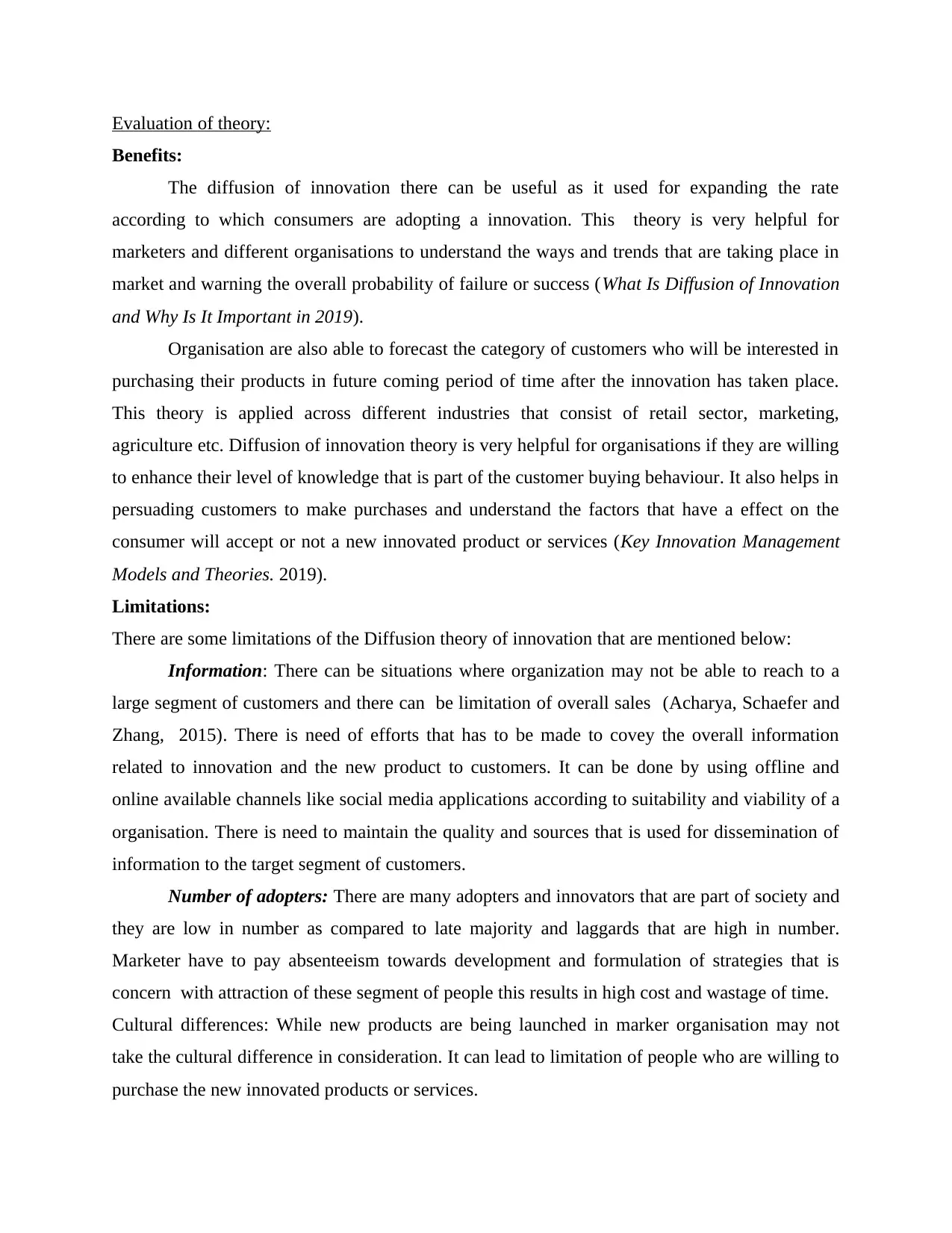
Evaluation of theory:
Benefits:
The diffusion of innovation there can be useful as it used for expanding the rate
according to which consumers are adopting a innovation. This theory is very helpful for
marketers and different organisations to understand the ways and trends that are taking place in
market and warning the overall probability of failure or success (What Is Diffusion of Innovation
and Why Is It Important in 2019).
Organisation are also able to forecast the category of customers who will be interested in
purchasing their products in future coming period of time after the innovation has taken place.
This theory is applied across different industries that consist of retail sector, marketing,
agriculture etc. Diffusion of innovation theory is very helpful for organisations if they are willing
to enhance their level of knowledge that is part of the customer buying behaviour. It also helps in
persuading customers to make purchases and understand the factors that have a effect on the
consumer will accept or not a new innovated product or services (Key Innovation Management
Models and Theories. 2019).
Limitations:
There are some limitations of the Diffusion theory of innovation that are mentioned below:
Information: There can be situations where organization may not be able to reach to a
large segment of customers and there can be limitation of overall sales (Acharya, Schaefer and
Zhang, 2015). There is need of efforts that has to be made to covey the overall information
related to innovation and the new product to customers. It can be done by using offline and
online available channels like social media applications according to suitability and viability of a
organisation. There is need to maintain the quality and sources that is used for dissemination of
information to the target segment of customers.
Number of adopters: There are many adopters and innovators that are part of society and
they are low in number as compared to late majority and laggards that are high in number.
Marketer have to pay absenteeism towards development and formulation of strategies that is
concern with attraction of these segment of people this results in high cost and wastage of time.
Cultural differences: While new products are being launched in marker organisation may not
take the cultural difference in consideration. It can lead to limitation of people who are willing to
purchase the new innovated products or services.
Benefits:
The diffusion of innovation there can be useful as it used for expanding the rate
according to which consumers are adopting a innovation. This theory is very helpful for
marketers and different organisations to understand the ways and trends that are taking place in
market and warning the overall probability of failure or success (What Is Diffusion of Innovation
and Why Is It Important in 2019).
Organisation are also able to forecast the category of customers who will be interested in
purchasing their products in future coming period of time after the innovation has taken place.
This theory is applied across different industries that consist of retail sector, marketing,
agriculture etc. Diffusion of innovation theory is very helpful for organisations if they are willing
to enhance their level of knowledge that is part of the customer buying behaviour. It also helps in
persuading customers to make purchases and understand the factors that have a effect on the
consumer will accept or not a new innovated product or services (Key Innovation Management
Models and Theories. 2019).
Limitations:
There are some limitations of the Diffusion theory of innovation that are mentioned below:
Information: There can be situations where organization may not be able to reach to a
large segment of customers and there can be limitation of overall sales (Acharya, Schaefer and
Zhang, 2015). There is need of efforts that has to be made to covey the overall information
related to innovation and the new product to customers. It can be done by using offline and
online available channels like social media applications according to suitability and viability of a
organisation. There is need to maintain the quality and sources that is used for dissemination of
information to the target segment of customers.
Number of adopters: There are many adopters and innovators that are part of society and
they are low in number as compared to late majority and laggards that are high in number.
Marketer have to pay absenteeism towards development and formulation of strategies that is
concern with attraction of these segment of people this results in high cost and wastage of time.
Cultural differences: While new products are being launched in marker organisation may not
take the cultural difference in consideration. It can lead to limitation of people who are willing to
purchase the new innovated products or services.
⊘ This is a preview!⊘
Do you want full access?
Subscribe today to unlock all pages.

Trusted by 1+ million students worldwide
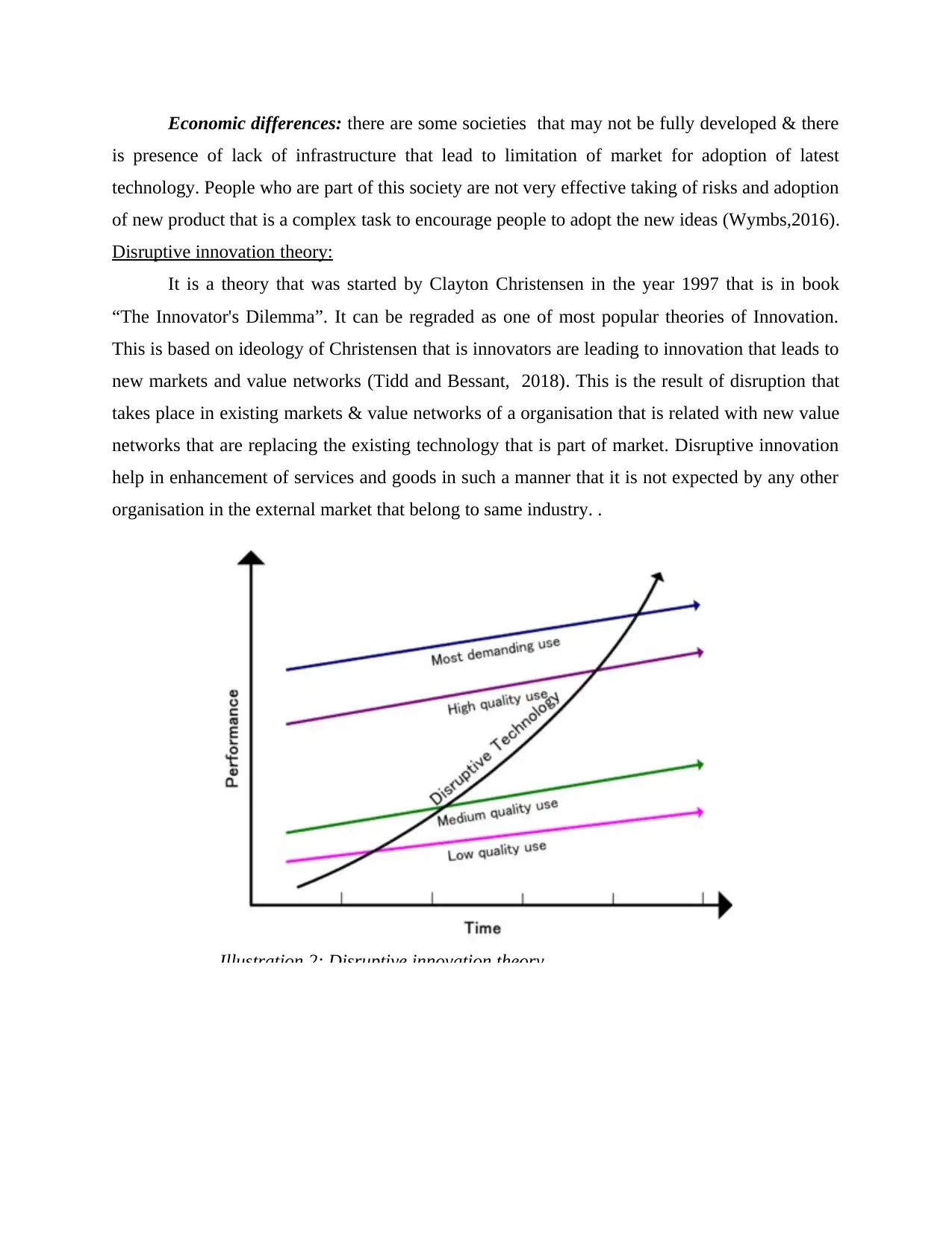
Economic differences: there are some societies that may not be fully developed & there
is presence of lack of infrastructure that lead to limitation of market for adoption of latest
technology. People who are part of this society are not very effective taking of risks and adoption
of new product that is a complex task to encourage people to adopt the new ideas (Wymbs,2016).
Disruptive innovation theory:
It is a theory that was started by Clayton Christensen in the year 1997 that is in book
“The Innovator's Dilemma”. It can be regraded as one of most popular theories of Innovation.
This is based on ideology of Christensen that is innovators are leading to innovation that leads to
new markets and value networks (Tidd and Bessant, 2018). This is the result of disruption that
takes place in existing markets & value networks of a organisation that is related with new value
networks that are replacing the existing technology that is part of market. Disruptive innovation
help in enhancement of services and goods in such a manner that it is not expected by any other
organisation in the external market that belong to same industry. .
Illustration 2: Disruptive innovation theory
is presence of lack of infrastructure that lead to limitation of market for adoption of latest
technology. People who are part of this society are not very effective taking of risks and adoption
of new product that is a complex task to encourage people to adopt the new ideas (Wymbs,2016).
Disruptive innovation theory:
It is a theory that was started by Clayton Christensen in the year 1997 that is in book
“The Innovator's Dilemma”. It can be regraded as one of most popular theories of Innovation.
This is based on ideology of Christensen that is innovators are leading to innovation that leads to
new markets and value networks (Tidd and Bessant, 2018). This is the result of disruption that
takes place in existing markets & value networks of a organisation that is related with new value
networks that are replacing the existing technology that is part of market. Disruptive innovation
help in enhancement of services and goods in such a manner that it is not expected by any other
organisation in the external market that belong to same industry. .
Illustration 2: Disruptive innovation theory
Paraphrase This Document
Need a fresh take? Get an instant paraphrase of this document with our AI Paraphraser
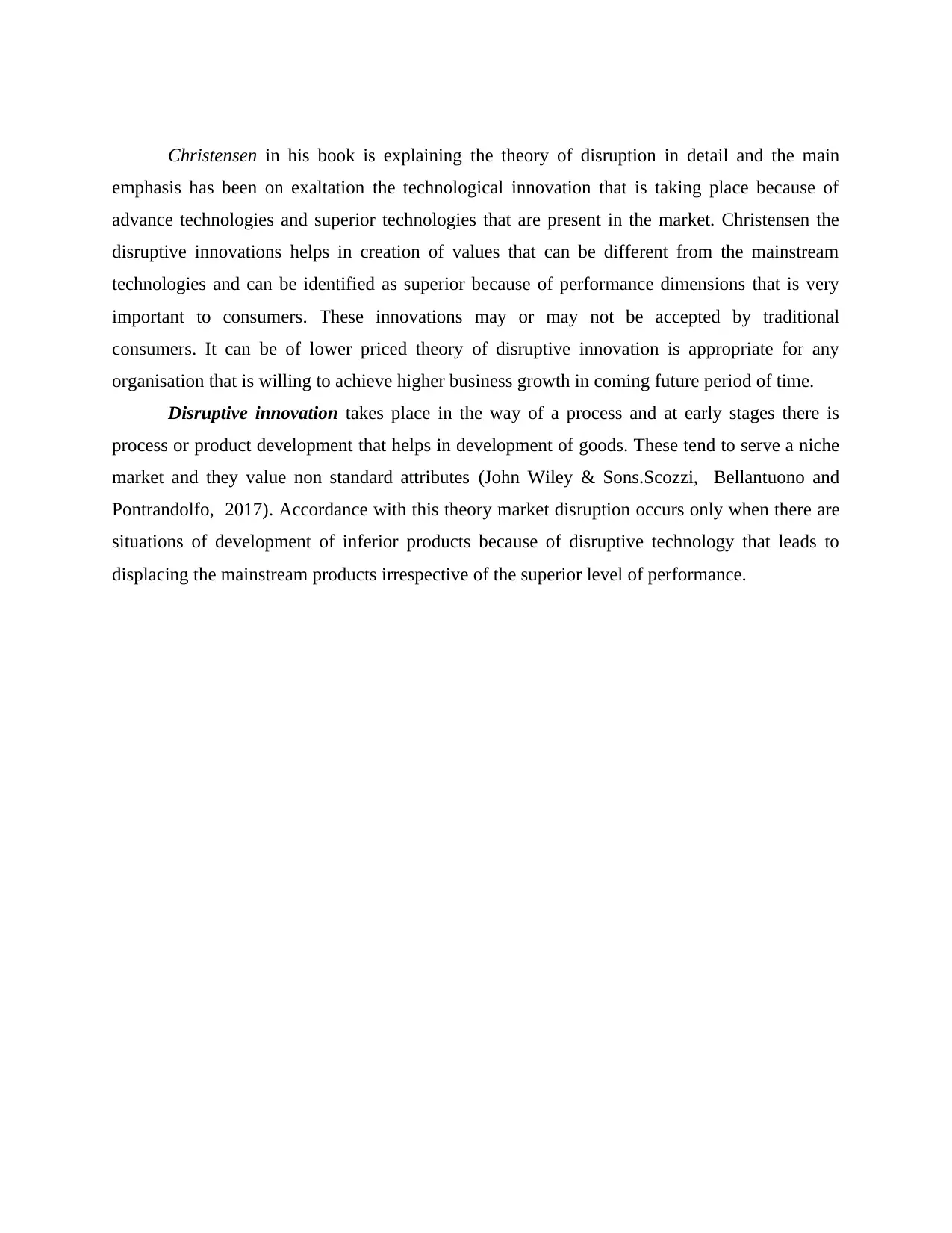
Christensen in his book is explaining the theory of disruption in detail and the main
emphasis has been on exaltation the technological innovation that is taking place because of
advance technologies and superior technologies that are present in the market. Christensen the
disruptive innovations helps in creation of values that can be different from the mainstream
technologies and can be identified as superior because of performance dimensions that is very
important to consumers. These innovations may or may not be accepted by traditional
consumers. It can be of lower priced theory of disruptive innovation is appropriate for any
organisation that is willing to achieve higher business growth in coming future period of time.
Disruptive innovation takes place in the way of a process and at early stages there is
process or product development that helps in development of goods. These tend to serve a niche
market and they value non standard attributes (John Wiley & Sons.Scozzi, Bellantuono and
Pontrandolfo, 2017). Accordance with this theory market disruption occurs only when there are
situations of development of inferior products because of disruptive technology that leads to
displacing the mainstream products irrespective of the superior level of performance.
emphasis has been on exaltation the technological innovation that is taking place because of
advance technologies and superior technologies that are present in the market. Christensen the
disruptive innovations helps in creation of values that can be different from the mainstream
technologies and can be identified as superior because of performance dimensions that is very
important to consumers. These innovations may or may not be accepted by traditional
consumers. It can be of lower priced theory of disruptive innovation is appropriate for any
organisation that is willing to achieve higher business growth in coming future period of time.
Disruptive innovation takes place in the way of a process and at early stages there is
process or product development that helps in development of goods. These tend to serve a niche
market and they value non standard attributes (John Wiley & Sons.Scozzi, Bellantuono and
Pontrandolfo, 2017). Accordance with this theory market disruption occurs only when there are
situations of development of inferior products because of disruptive technology that leads to
displacing the mainstream products irrespective of the superior level of performance.
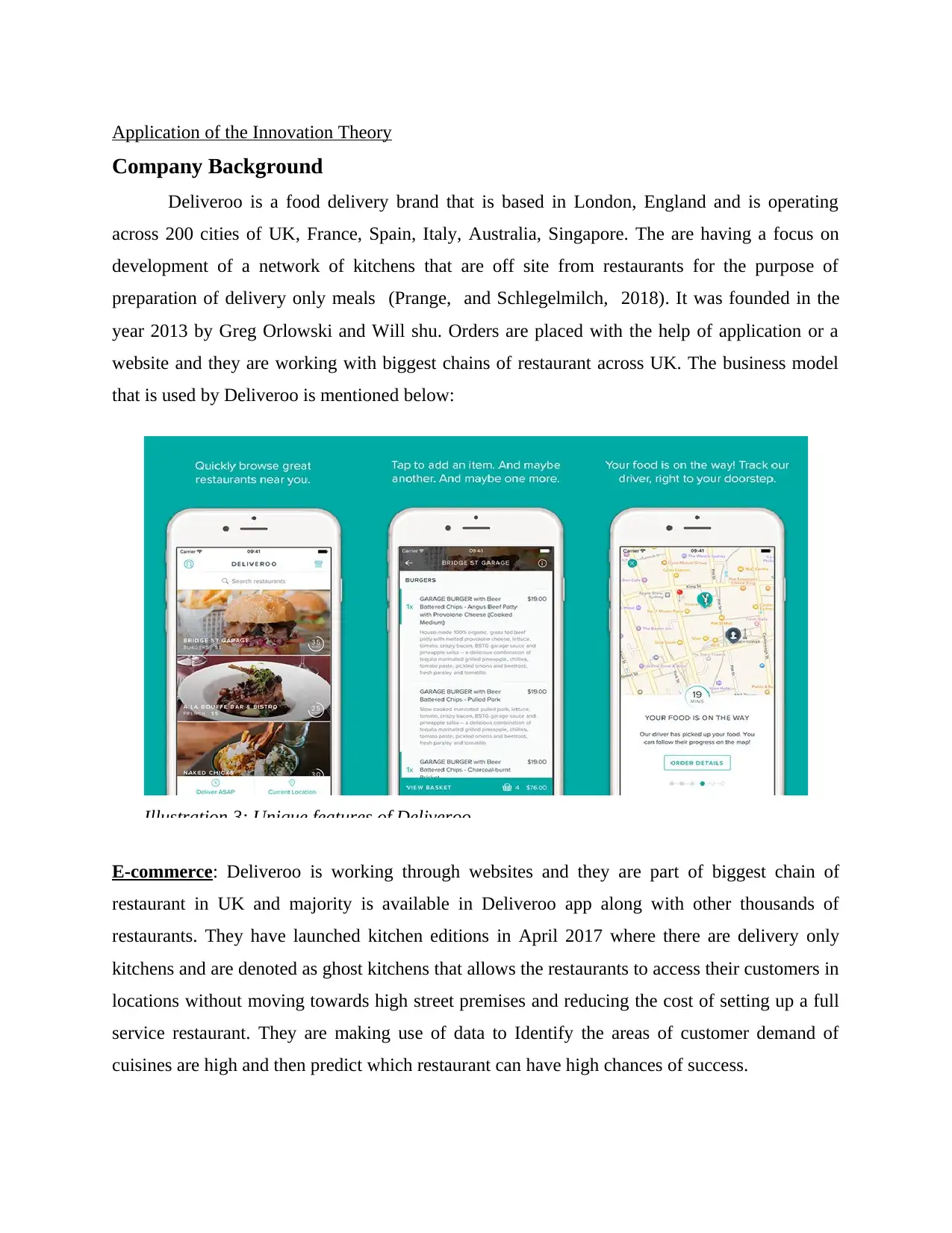
Application of the Innovation Theory
Company Background
Deliveroo is a food delivery brand that is based in London, England and is operating
across 200 cities of UK, France, Spain, Italy, Australia, Singapore. The are having a focus on
development of a network of kitchens that are off site from restaurants for the purpose of
preparation of delivery only meals (Prange, and Schlegelmilch, 2018). It was founded in the
year 2013 by Greg Orlowski and Will shu. Orders are placed with the help of application or a
website and they are working with biggest chains of restaurant across UK. The business model
that is used by Deliveroo is mentioned below:
E-commerce: Deliveroo is working through websites and they are part of biggest chain of
restaurant in UK and majority is available in Deliveroo app along with other thousands of
restaurants. They have launched kitchen editions in April 2017 where there are delivery only
kitchens and are denoted as ghost kitchens that allows the restaurants to access their customers in
locations without moving towards high street premises and reducing the cost of setting up a full
service restaurant. They are making use of data to Identify the areas of customer demand of
cuisines are high and then predict which restaurant can have high chances of success.
Illustration 3: Unique features of Deliveroo
Company Background
Deliveroo is a food delivery brand that is based in London, England and is operating
across 200 cities of UK, France, Spain, Italy, Australia, Singapore. The are having a focus on
development of a network of kitchens that are off site from restaurants for the purpose of
preparation of delivery only meals (Prange, and Schlegelmilch, 2018). It was founded in the
year 2013 by Greg Orlowski and Will shu. Orders are placed with the help of application or a
website and they are working with biggest chains of restaurant across UK. The business model
that is used by Deliveroo is mentioned below:
E-commerce: Deliveroo is working through websites and they are part of biggest chain of
restaurant in UK and majority is available in Deliveroo app along with other thousands of
restaurants. They have launched kitchen editions in April 2017 where there are delivery only
kitchens and are denoted as ghost kitchens that allows the restaurants to access their customers in
locations without moving towards high street premises and reducing the cost of setting up a full
service restaurant. They are making use of data to Identify the areas of customer demand of
cuisines are high and then predict which restaurant can have high chances of success.
Illustration 3: Unique features of Deliveroo
⊘ This is a preview!⊘
Do you want full access?
Subscribe today to unlock all pages.

Trusted by 1+ million students worldwide
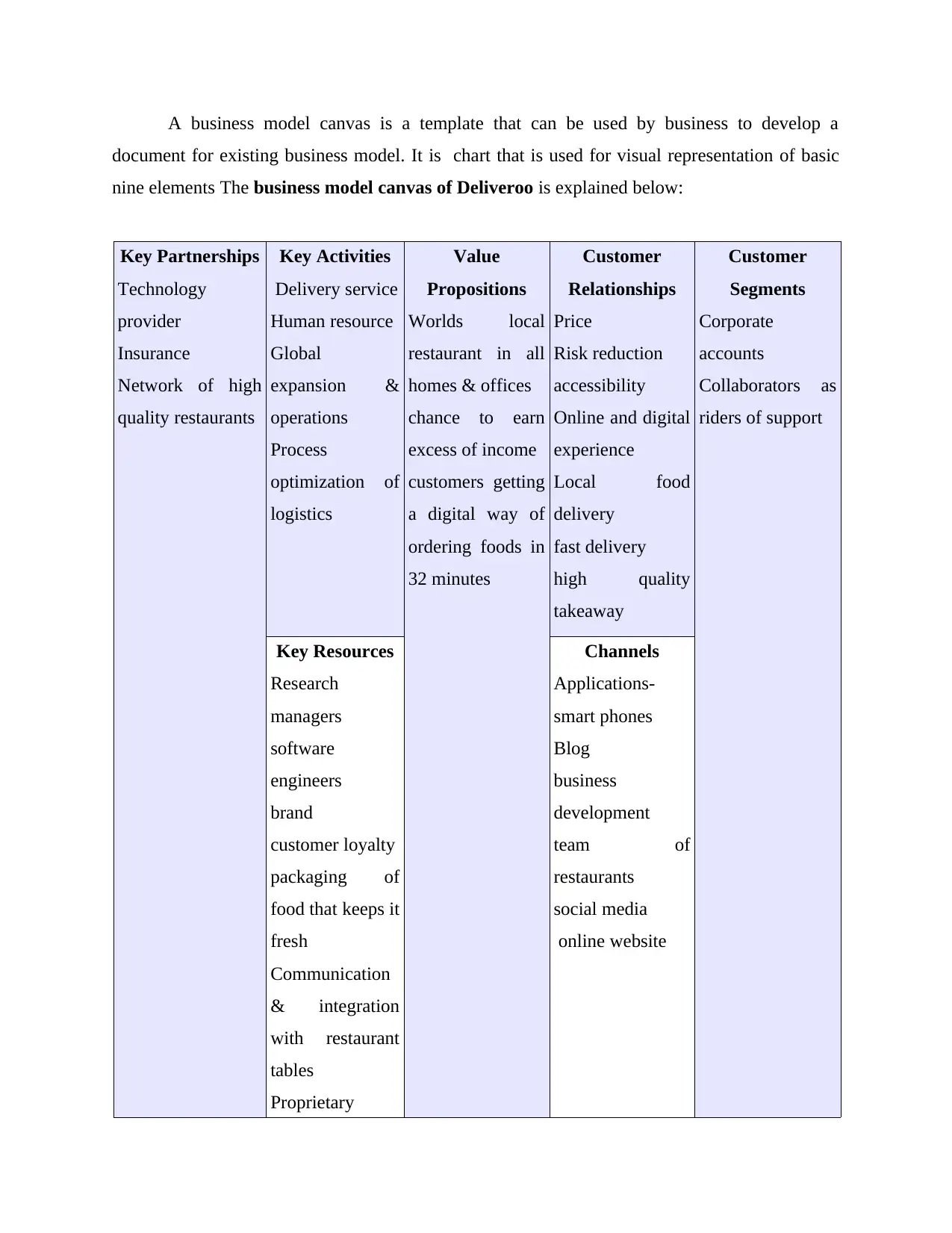
A business model canvas is a template that can be used by business to develop a
document for existing business model. It is chart that is used for visual representation of basic
nine elements The business model canvas of Deliveroo is explained below:
Key Partnerships
Technology
provider
Insurance
Network of high
quality restaurants
Key Activities
Delivery service
Human resource
Global
expansion &
operations
Process
optimization of
logistics
Value
Propositions
Worlds local
restaurant in all
homes & offices
chance to earn
excess of income
customers getting
a digital way of
ordering foods in
32 minutes
Customer
Relationships
Price
Risk reduction
accessibility
Online and digital
experience
Local food
delivery
fast delivery
high quality
takeaway
Customer
Segments
Corporate
accounts
Collaborators as
riders of support
Key Resources
Research
managers
software
engineers
brand
customer loyalty
packaging of
food that keeps it
fresh
Communication
& integration
with restaurant
tables
Proprietary
Channels
Applications-
smart phones
Blog
business
development
team of
restaurants
social media
online website
document for existing business model. It is chart that is used for visual representation of basic
nine elements The business model canvas of Deliveroo is explained below:
Key Partnerships
Technology
provider
Insurance
Network of high
quality restaurants
Key Activities
Delivery service
Human resource
Global
expansion &
operations
Process
optimization of
logistics
Value
Propositions
Worlds local
restaurant in all
homes & offices
chance to earn
excess of income
customers getting
a digital way of
ordering foods in
32 minutes
Customer
Relationships
Price
Risk reduction
accessibility
Online and digital
experience
Local food
delivery
fast delivery
high quality
takeaway
Customer
Segments
Corporate
accounts
Collaborators as
riders of support
Key Resources
Research
managers
software
engineers
brand
customer loyalty
packaging of
food that keeps it
fresh
Communication
& integration
with restaurant
tables
Proprietary
Channels
Applications-
smart phones
Blog
business
development
team of
restaurants
social media
online website
Paraphrase This Document
Need a fresh take? Get an instant paraphrase of this document with our AI Paraphraser
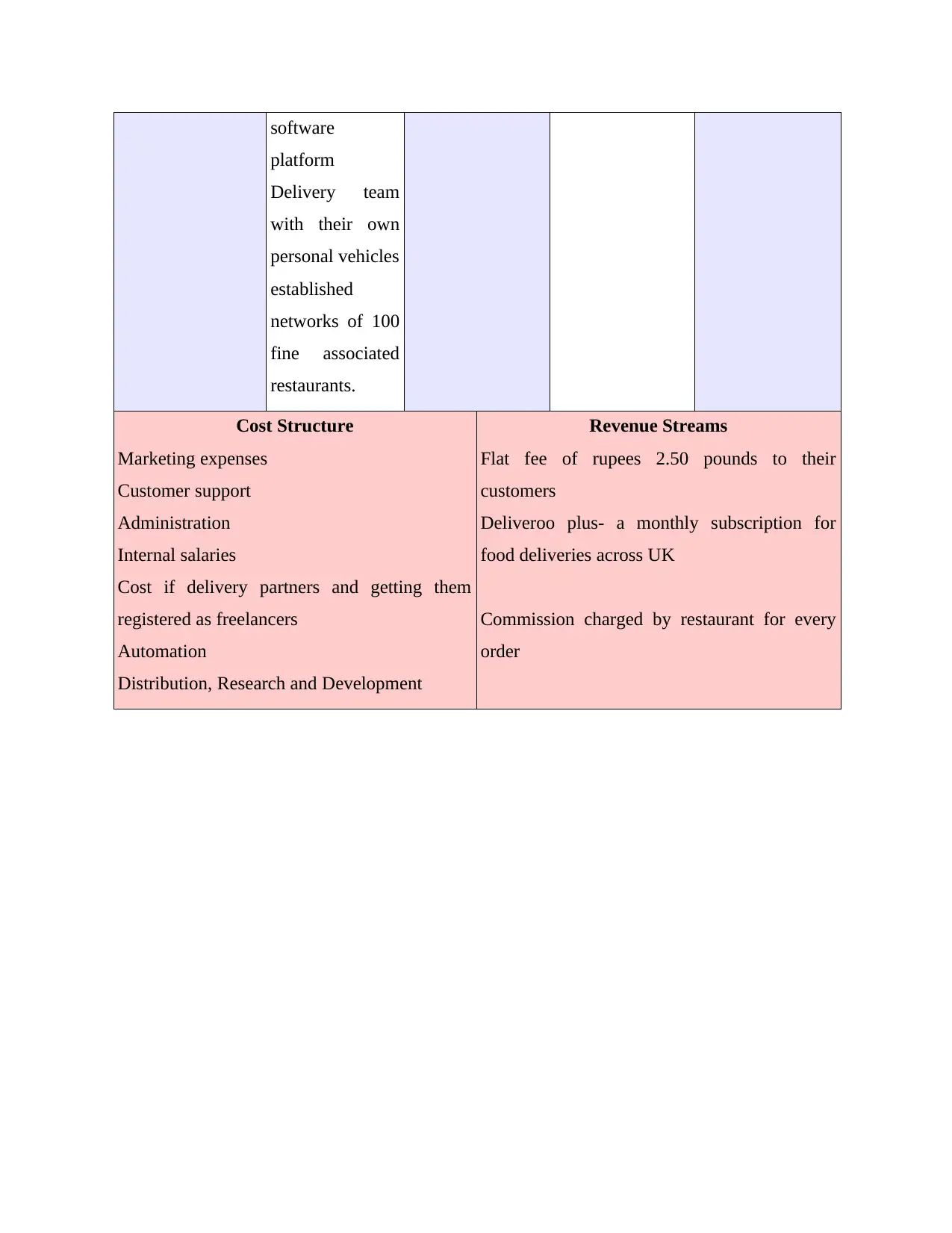
software
platform
Delivery team
with their own
personal vehicles
established
networks of 100
fine associated
restaurants.
Cost Structure
Marketing expenses
Customer support
Administration
Internal salaries
Cost if delivery partners and getting them
registered as freelancers
Automation
Distribution, Research and Development
Revenue Streams
Flat fee of rupees 2.50 pounds to their
customers
Deliveroo plus- a monthly subscription for
food deliveries across UK
Commission charged by restaurant for every
order
platform
Delivery team
with their own
personal vehicles
established
networks of 100
fine associated
restaurants.
Cost Structure
Marketing expenses
Customer support
Administration
Internal salaries
Cost if delivery partners and getting them
registered as freelancers
Automation
Distribution, Research and Development
Revenue Streams
Flat fee of rupees 2.50 pounds to their
customers
Deliveroo plus- a monthly subscription for
food deliveries across UK
Commission charged by restaurant for every
order
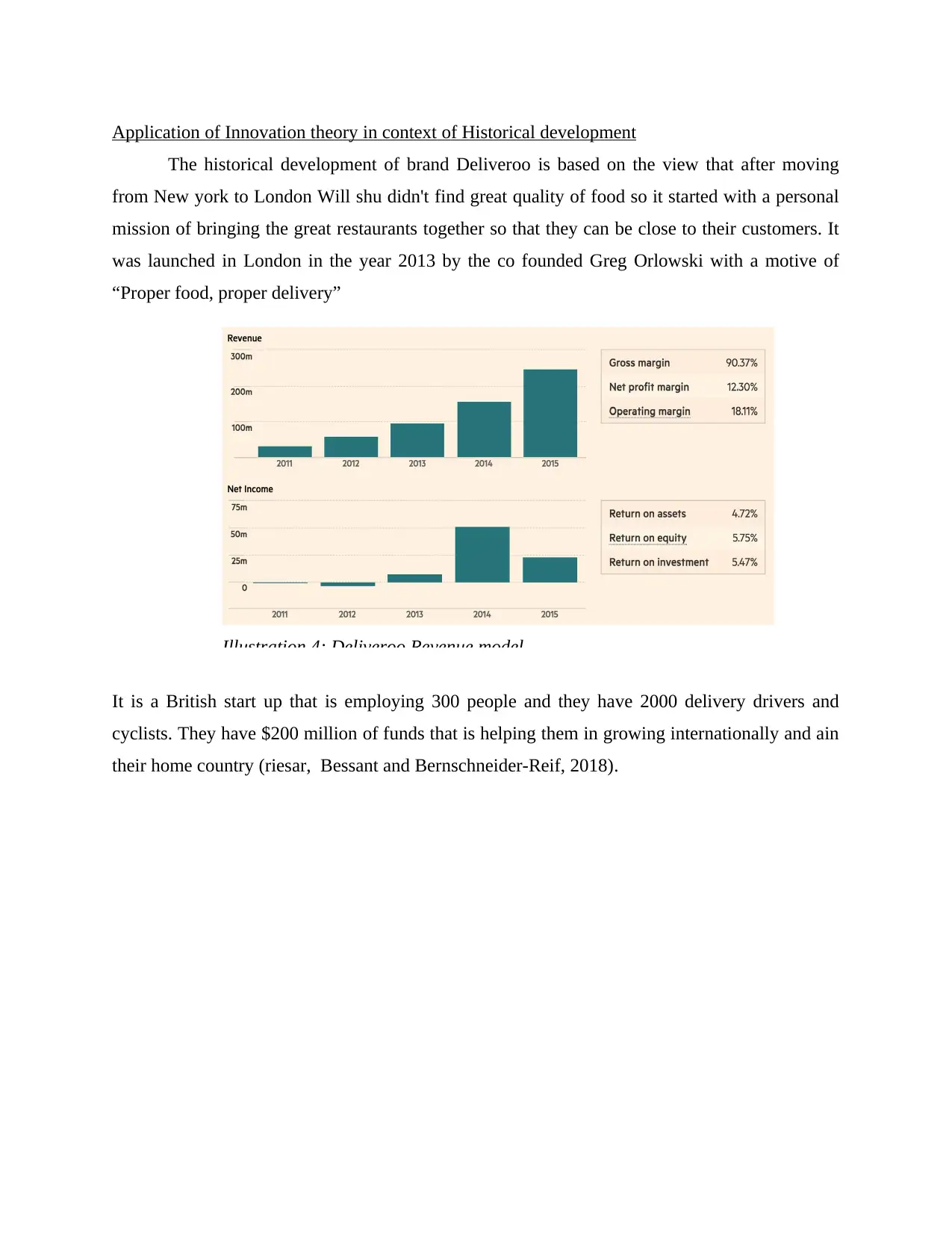
Application of Innovation theory in context of Historical development
The historical development of brand Deliveroo is based on the view that after moving
from New york to London Will shu didn't find great quality of food so it started with a personal
mission of bringing the great restaurants together so that they can be close to their customers. It
was launched in London in the year 2013 by the co founded Greg Orlowski with a motive of
“Proper food, proper delivery”
It is a British start up that is employing 300 people and they have 2000 delivery drivers and
cyclists. They have $200 million of funds that is helping them in growing internationally and ain
their home country (riesar, Bessant and Bernschneider‐Reif, 2018).
Illustration 4: Deliveroo Revenue model
The historical development of brand Deliveroo is based on the view that after moving
from New york to London Will shu didn't find great quality of food so it started with a personal
mission of bringing the great restaurants together so that they can be close to their customers. It
was launched in London in the year 2013 by the co founded Greg Orlowski with a motive of
“Proper food, proper delivery”
It is a British start up that is employing 300 people and they have 2000 delivery drivers and
cyclists. They have $200 million of funds that is helping them in growing internationally and ain
their home country (riesar, Bessant and Bernschneider‐Reif, 2018).
Illustration 4: Deliveroo Revenue model
⊘ This is a preview!⊘
Do you want full access?
Subscribe today to unlock all pages.

Trusted by 1+ million students worldwide
1 out of 20
Related Documents
Your All-in-One AI-Powered Toolkit for Academic Success.
+13062052269
info@desklib.com
Available 24*7 on WhatsApp / Email
![[object Object]](/_next/static/media/star-bottom.7253800d.svg)
Unlock your academic potential
Copyright © 2020–2025 A2Z Services. All Rights Reserved. Developed and managed by ZUCOL.
![Innovation Theory Application: BrewDog Case Study Report, [University]](/_next/image/?url=https%3A%2F%2Fdesklib.com%2Fmedia%2Fimages%2Fgi%2Ffaaf6e5fa9b9466fb73a32cec25c50a0.jpg&w=256&q=75)




